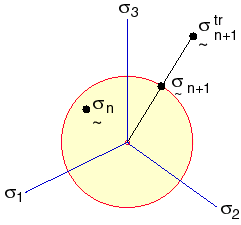In the theory of large strain plasticity, a logarithmic strain measure is defined as:

where U is the right stretch tensor usually obtained from the right polar decomposition of the deformation gradient F (i.e., F = R U; R is the rotation tensor). The incremental logarithmic strain is estimated as:

where B(n+1/2) is the strain-displacement matrix estimated at solution step n+1/2 and Δu is the incremental displacements vector. It is noted that the above form is a second-order approximation to the exact formula.
The stress rate is taken as the Green-Naghdi rate so as to make the constitutive model properly frame-invariant or objective. By transforming the stress rate from the global system to the R-system:

The entire constitutive model will be form-identical to the small strain theory. The large strain plasticity theory is applied to the von Mises yield criterion, associative flow rule and isotropic or kinematic hardening (bilinear or multi-linear). Temperature-dependency of material property is supported by bilinear hardening. The radial-return algorithm is used in the current case. The basic idea is to approximate the normal vector N by:

where 
The following figure illustrates the above two equations.

The element force vector and stiffness matrices are computed based on the updated Lagrangian formulation. The Cauchy stresses, logarithmic strains and current thickness (shell elements only) are recorded in the output file.
The elasticity in the current case is modeled in hyperelastic form that assumes small elastic strains but allows for arbitrarily large plastic strains. For large strain elasticity problems (rubber-like), you can use hyperelastic material models such as Mooney-Rivlin.
Cauchy (true) stress and logarithmic strain should be used in defining the multi-linear stress-strain curve.